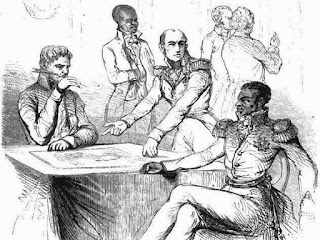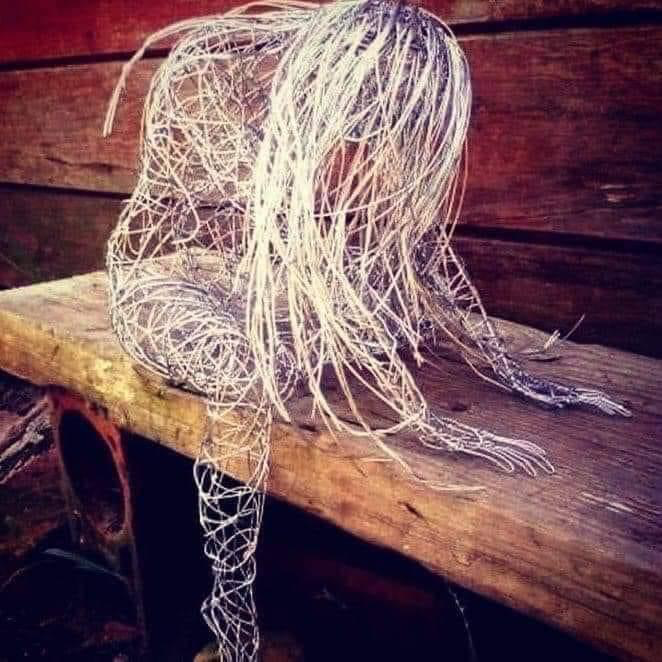Our journey starts in a racially fragmented settlement in what was known as Hispaniola. Here, in 1789 on the eve of the French Revolution, some 500,000 enslaved Africans and 24,000 affranchis (free mulattoes) banded together and began challenging the continual brutality of slave owners. The first real challenge occurred in late 1790 as an uprising was precipitated by a mulatto named Vincent Ogé. Although the rebellion was unsuccessful, Ogé was captured, tortured, and ultimately executed;\. The French government attempted to split the opposition by granting citizenship to the wealthier affranchise. However, the acts of appeasement were disregarded as most of the Europeans within Haiti's population violated the law. Continual acts of violence targeting the slaves and mulattos provoked a more serious confrontation led by Toussaint Louverture in the late 1790s. Louverture was successful in January 1801 as he conquered Santa Domingo and declared himself "governor-general for life."
In 1802, Napoléon Bonaparte, in an effort to restore order, sent his brother-in-law, Gen. Charles Leclerc to the embattled island. Leclerc landed with an estimated 23,000 seasoned French troops. (Brittanica 2022) Outgunned, the rebel leaders and their troops, were quickly overpowered. Louverture and several of his lieutenants were imprisoned. Although a truce was declared, no conditions were honored as Louverture languished and ultimately died in prison. Several of Toussaint's lieutenants, such as Jean-Jacques Dessalines and Henry Christopher, took up arms again. Napolean, fighting essentially a war on 3 sides (the rebels, England and Spain) began devising an exit plan. It was this that led him to decide to sell many of his holdings in North America resulting in the Louisiana Purchase in May of 1803. The rebellion continued, as France and Britian fought to gain control over the island. Seeing the writing on the walls, Napoleon quickly sought an escape route. He found one in the Louisiana Purchase in May 1803 and formally withdrew from North America. In three weeks, France and Britain fought to gain control over Haiti. Taking advantage of this conflict, Haitian rebels, now under the leadership of Dessalines, defeated the French. On January 1, 1804, the island was declared independent. Ironically, most European powers, including the United States, fearing slave revolts, ostracized the newly liberated Haiti.
Two decades later, France sent an armada consisting of
fourteen French warships equipped with 558 cannons, demanding reparations to
compensate for its loss of property, including enslaved people, land, and other
property. The French demanded 150
million francs to be paid in 5 equal installments. The first payment alone, at 30 million
francs, was six times the GDP of the new Nation. The continual payments on the debt were only
possible through exorbitant loans, high import taxes, and, ultimately, a 2nd
revolution. And on this day, Haitians
made history by becoming the first and only former slaves forced to pay reparations
to their former enslavers. (Porter,
Meheut, Apuzzo and Gebrekidan 2022) Haiti went from being the crown jewel of
the French empire, one of the most successful colonies in the world, to one of the
poorest in the world. The country that
had produced massive amounts of sugar, coffee, and other cash crops was reduced
to a pariah state by world powers. (Rosalsky
2021)
The Baron de
Mackau of France presented demands to Jean-Pierre Boyer, President of Haiti, in
1825
Wikipedia
The presence of a nation of formerly enslaved Black people was
an existential threat to European imperialism and the existing racial world
order. Jefferson, who espoused the
tenants of the French Revolution, was nevertheless a Virginia slaveholder. Jefferson feared the revolt of slaves would
spread to the United States. He,
therefore, actually provided federal aid to help suppress the rebellion. He also worked to isolate Haiti both
diplomatically and economically. (Rosalky
ibid) Even Federalist rivals, such as
Alexander Hamilton, supported Jefferson's Haitian policy. The most immediate response was the formal
silence of the United States. Responding
to the fear and pressure of Southern slave-holding states, the United States
government refused to recognize Haitian independence. Ironically, it was not until 1852, with the
civil war, was Haitian independence finally realized. (Blackburn 2006)
The United States continued to isolate, intimidate, and problematize
the newly independent Haiti through much of the early 19th century. It, through force, occupied the Nation and
remained there for 19 years in the early 20th century. Even after the U.S. withdrew its troops in
1934, it continued to control its finances until 1947. According to estimates, the U.S. stole approximately
40% of Haiti's GDP to repay the debt to the U.S. and France. The Marine Corps General in command of the
joint occupation of Haiti and the Dominican Republic, Smedley Butler, confessed
that he had been essentially a "high-class muscle man for Big Business"
and that he was "a gangster for capitalism" As he had "helped
make Haiti…a decent place for the National City Bank Boys". (Danticat
2015) Perhaps to clean up its image, National City Bank's board of directors
changed its name to Citigroup in 1967.
Foreign intervention served to destabilize the fragile state
continually. Extreme poverty, high crime,
and political instability left thousands killed, massive human rights
violations, and repeated revolutions. U.S.
involvement continued through the 20th century, as Aristide and then
Martelly was forced to step down. And
then, on July 7, 2021, U.S.-trained mercenaries assassinated Jovenel Moïse.
Haiti, once the jewel of the Caribbean, is now the pariah as
U.S. and other world powers orchestrated the demise of this Black-led Nation. As we have seen, over the last two centuries,
continuing up to this day, Haiti has been targeted, occupied, marginalized, ostracized,
and exploited. As a
result, Haiti is the poorest Nation in our hemisphere. The same policies, practices, and intentional
strategies that created such a nation, would be duplicated, refined, and
reinvented as our Nation discovered Jim Crow, redlining, the cradle-to-prison
pipeline, and the resulting ghettos.



Comments
Post a Comment